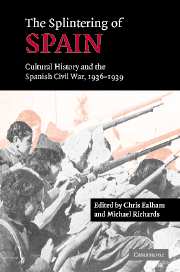Book contents
- Frontmatter
- Contents
- List of illustrations
- List of maps
- List of contributors
- Preface
- List of abbreviations
- Chronology
- Maps showing the division of Spain, 1936-1939
- 1 History, memory and the Spanish civil war: recent perspectives
- Part I Overviews: violence, nationalism and religion
- 2 The symbolism of violence during the Second Republic in Spain, 1931–1936
- 3 Nations in arms against the invader: on nationalist discourses during the Spanish civil war
- 4 ‘The keys of the kingdom’: religious violence in the Spanish civil war, July–August 1936
- Part II Republican political and cultural projects
- Part III Identities on the Francoist side
- Notes
- Index
2 - The symbolism of violence during the Second Republic in Spain, 1931–1936
Published online by Cambridge University Press: 28 July 2009
- Frontmatter
- Contents
- List of illustrations
- List of maps
- List of contributors
- Preface
- List of abbreviations
- Chronology
- Maps showing the division of Spain, 1936-1939
- 1 History, memory and the Spanish civil war: recent perspectives
- Part I Overviews: violence, nationalism and religion
- 2 The symbolism of violence during the Second Republic in Spain, 1931–1936
- 3 Nations in arms against the invader: on nationalist discourses during the Spanish civil war
- 4 ‘The keys of the kingdom’: religious violence in the Spanish civil war, July–August 1936
- Part II Republican political and cultural projects
- Part III Identities on the Francoist side
- Notes
- Index
Summary
One of the most provocative stances which can be adopted in the study of political violence is to interpret it as a specific type of communication that aims forcibly to modify certain modes of public behaviour. Contrary to what might appear to be the case at first sight, violence does not involve the complete rupture of all channels of contact and exchange. It can also be understood as a mode of interlocution which, in certain extreme circumstances, may end up being the only alternative in the absence of other more constructive means of interaction. It is a social relationship of an undoubtedly asymmetrical nature, but one which nevertheless still imposes the necessity of an exchange and presupposes some kind of response after an initial escalation of demands, pressure and threats. Communication theory has acknowledged this peculiar characteristic of violence by defining it as a specific type of extra-linguistic communication, a ‘system of social communication in which aggressive social interaction becomes an integral part of the expressive repertoire for codifying and decodifying mythical references of a political nature’. Violence and language are situated at the opposite poles of a continuum. Language constitutes a pure and constructive mode of interaction: it presupposes an unlimited consensus and requires the comprehension of the message, the truth of what is said, the pragmatic relevance of the act and the authenticity of the communicator.
- Type
- Chapter
- Information
- The Splintering of SpainCultural History and the Spanish Civil War, 1936–1939, pp. 23 - 44Publisher: Cambridge University PressPrint publication year: 2005
- 3
- Cited by



